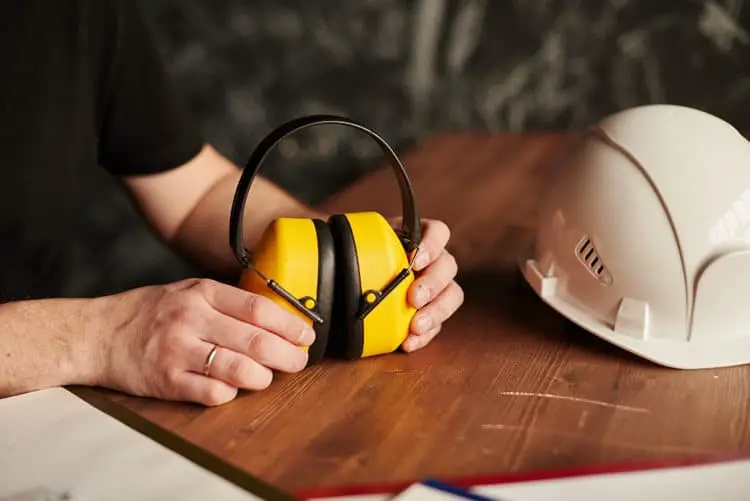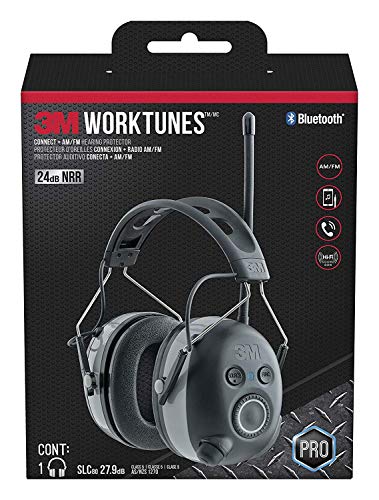As a child, there were always earplugs lying around my grandparent’s house or found inside my granddad’s pockets.
He worked at a power station as a boiler attendant. He got so used to them; sometimes he even forgot that he had them in.
He often complained about the noise levels, and because of prolonged exposure to it, he has hearing loss today.
Surely, had he considered dual protection, this could have been prevented; information just wasn’t as freely available back then.
Wearing Earplugs and Earmuffs Together for Added Protection
Wearing earplugs and earmuffs simultaneously will not double your hearing protection, but you can expect to add 5 dB to the higher Noise Reduction Rating (NRR), which can be the difference between a safe listening environment and hearing loss.
According to the NIOSH, if what you need to stay safe is an extra 5 to 10 decibels, then wearing double protection can assure you of that. This can make the difference needed for you to move from insufficient to maximum protection. Neglecting this for just a short period can decrease the effective protection radically.
Understanding when to wear both muffs and plugs is pretty standard. Both have a dB rating; this will tell you how much noise reduction you’ll be able to achieve when you wear them.
Whatever the products dB rating is, the noise level of your environment will reduce with that same amount.
If, for example, your earmuffs have a 30dB rating and your environment is 120 dB, your muffs will reduce the noise to 90dB.
Why You Should Wear Earplugs and Earmuffs Together
There are some noisy environments where the dB rating is so high that it is considered extremely hazardous. In these situations wearing both earmuffs and earplugs together isn’t a choice but a given if you want to achieve the maximum protection from that noise.
This is not the case for general industries, as stipulated by OSHA regulations. For instance, in mining operations, governed by MSHA, where noise exposures are 105 dBA, and over, it is compulsory.
Workers clocking 8 hours time-weight average (TWA) a day in environments with a noise exposure of 85 dB or more are required to follow a hearing conservation program as per the OSHA.
NIOSH has a similar guideline document recommending dual protection when being exposed to 100 dBA for 8 hours TWA (time-weighted average).
There is some speculation to this requirement, with some viewing it as being overly cautious.
It is sometimes assumed that this is mostly applicable to workers who might not be wearing their hearing protectors properly. With dual protection, they are assured safety perhaps.
On the other hand, studies have proven that sounds above 85 dBA and more can possibly damage your hearing over a prolonged period of time. If sounds are at 70 dBA or below, the environment is considered safe. Rather be safe than sorry, right?
There are certain internal safety policies at some companies where you are required to wear dual protection when you are in a specific work area. Here you’ll find equipment that is much noisier, reaching a higher noise level.
A big downside to wearing dual protection is that you’ll hear so little that it might be difficult hearing warning signals you should be cautious of.
So, the correct balance must be found, and I am sure that in some cases you’ll have to compromise a bit on one or the other.
■ Hearing Protection from Wearing Ear Plugs Alone
Earplugs sometimes have the same NRR rating as earmuffs with a max NRR of 36 dB compared to muffs, which max out at NRR 37 dB. They can literally rescue your hearing health. Some, like me, struggle to wear them though, my ears are funny like that, and they’re always popping out.
However, if you find the right pair that fits comfortably, they will do just fine in a noisy environment.
They basically just plug straight into your ear canal, and keep any sound out. They’re also much more comfortable than earmuffs, which can be big and bulky.
Companies also benefit from providing earplugs instead of earmuffs because they’re much more cost-effective and are bought in bulk.
Also beneficial are the electronic options available. These are basically hearing aids that can assist in offering protection.
In order to gain the full benefits that earplugs have to offer, you have to make sure that they fit 100% correctly. If you go about your day thinking you are protected, you can unknowingly be harming your hearing.
The best ear plugs to wear are the ones that have a foam tip; they will provide the largest sound reduction. And being made from foam once plugged in, they form to your ear. (So one size would fit all!).
These get worn out eventually and compressed permanently, so you’ll have to replace them from time to time.
▪️ Advantages of Earplugs
- Earplugs will sometimes provide you with a higher level of protection from noise than earmuffs because they will fit directly into your ear canal, closing it completely as opposed to ear muffs which have to custom fitted to give you maximum protection.
- They are very light to carry around. Workers easily keep them in their pockets sealed in their protective packaging.
- They are comfortable and will not interfere with the wear of glasses or where a safety helmet is compulsory.
▪️ Disadvantages of Earplugs
- They can be difficult to fit properly. There are some that require special instructions that the wearer has to follow to get them plugged. And this does not work for everyone.
- If not inserted properly, they easily pop out, exposing you to the noise around you. Exposure for just a short period of time can be harmful.
- Being so small they get lost easily and safety inspectors might find them hard to spot. A great solution to this is the bright color designs by Honeywell (Amazon link).
■ Hearing Protection from Wearing Ear Muffs Alone
If you work in an environment where you need to protect your ears, but you have a choice of what to wear, earmuffs could be a more comfortable option for some.
Especially if you are not a fan of earplugs. Once on your head, they can’t pop out like the plugs.
- 31 dB Noise Reduction Rating (NRR)
- Perfect for Construction, Manufacturing, Automotive, Woodworking, Heavy Engineering, Mining
The 3M Peltor X5A (Amazon link) is a very comfortable over-the-head earmuff that has a very high NRR of 31 dB (among the highest on the market). You’ll possibly find them very practical for use.
What makes them, even more, easy-to-use is, after a quick adjustment, you can effortlessly take them off and put them back on numerous times in a day.
Plugs can be a bit of a mission to insert, and once in, you will probably not take them out until the end of the day.
Just like sharing headphones is a recipe for disaster, it might not be the best idea to lend your ear muffs to a friend or colleague. Let’s face it; no one borrows out their earplugs, gross!
- 24 dB Noise Reduction Rating (NRR)
- Bluetooth Connectivity
- Great Microphone to Receive and Make Phone Calls
- Outstanding AM/FM Radio Performance
- Crisp and Clear Sound
- Bass Boost Option
Some electronic earmuff options available have really cool functions. The 3M WorkTunes Connect (Amazon link), for example, features Bluetooth, AM/FM radio, and you can tend to phone calls through its microphone without removing it.
They have an NRR of 24 dB, more than enough for moderately noisy areas. Bearing in mind, no matter how great, they still need to fit perfectly to provide the protection needed, which is its ultimate purpose.
▪️ Advantages of Earmuffs
- Earmuffs are practically universal, but contrary to common belief they do need to be fitted in order to maximize their effectiveness. The good thing is that they can easily be adjusted and therefore, are designed in a standard size with little variations.
- When Safety inspectors are doing their rounds, they are spotted with ease. This also makes it hard to lose.
- For the unfortunate people that work outside in the dead of winter, they have a multi-purpose of serving as ear warmers. Construction workers and landscapers really value this factor.
- Wearing earphones when the noise is reduced or not present could become quite boring. Therefore electronic ear muffs offer microphones that receive ambient sounds, which are then played back through the built-in drivers.
This is an automatic system that will switch off when loudness is detected for your safety. - Other electronic muffs are equipped with an audio jack input to allow you to listen to music or have phone conversations.
▪️ Disadvantages of Earmuffs
- Those outdoor workers might benefit in winter, but in the hot and humid summer months wearing earmuffs can become very uncomfortable.
- People wearing glasses find it difficult to fit muffs securely because the ear hooks prevent this.
- They do not provide the same amount of protection since they don’t block the ear canal like an earplug, which provides a good seal against extreme noise.
Does Wearing Earplugs and Earmuffs Together Mean Double Protection?
In extremely high sound frequency areas wearing earplugs and earmuffs together will provide you with more protection than wearing only one of them. Separately they each have a certain amount of NRR dB protection, but combining the two does not mean those numbers get added together. So, the answer is no, wearing them together cannot offer double protection.
Sound gets conducted through the bones, which results in some of the sound bypassing the safeguards.
This makes them less effective. How well doubling up gives you extra protection is directly influenced by the frequency of the sound. The added protection decreases, for instance, when the frequency is 2000Hz.
Some earmuffs are very advanced, and the need for dual protection will be entirely eliminated. The need for doubling up is quite rare.
At times the sole reason for having to do this is to test people’s ergonomics and has little to do with hearing protection.
If you do find yourself in a workplace where doubling up is compulsory, and you seek to reap the benefits of doing so, then a well-fitted earplug is the secret.
Considering earplugs offer you more protection compared to muffs, achieving its full protection will leave you with very little to make for from your earmuffs.
So that begs the question, if adding earmuffs does not double up your protection, is it even worth it? And in those extremely noisy situations, absolutely.
Say, for example, your earplugs provide you with 30 dB of protection, when adding earmuffs that increase to 35 dB.
What happens then is that it reduces the noise your eardrum is exposed to with nearly one third – diminishing your risk of hearing loss substantially.
■ When You Actually Need to Wear Earplugs and Earmuffs Together
In this study on hearing loss, it is explained that you’re at risk from 85 dB and up. Many believe you should start wearing both just before it becomes extremely dangerous. At 105 dB, as per The Mine Safety and Health Administration (MSHA), double hearing protection is compulsory. Therefore around 100 dB, you should start thinking about wearing plugs and muffs together.
Industrial Work environments very rarely exceed 100 dB. With an estimated average of 97 % never going above that.
Only if it does, would you need to wear your earplugs and earmuffs together. Mostly though, one or the other, should provide ample protection.
The other 3 percent of industries were dual protection is advised consists of:
- Certain construction or manufacturing jobs
- Mining
- Quarrying
- Air traffic control
Ear protective devices receive an NRR rating. This means that they’ve been tested to withstand the number of decibels corresponding to their rating.
A standard set of earplugs will be around 20 NRR (20 dB of protection). In other words, wearing earplugs of 20 dB provides you with protection for up to 105 dB (adding 85+20).
In a low-frequency setting, you will need higher protection. The lower the frequency, the more you are going to have to up your protection.
When it comes to earplugs, you can purchase ones with up to 36 NRR. With earmuffs, the highest level of protection is 37 dB (Amazon link).
- Incredible 37 dB Noise Reduction Rating (NRR)
- Extremely Comfortable Headband
- Perfect for Long Work Hours
- For Kids and Adults Alike
- Ideal for Construction Work, Lawn Mowing, Sporting Events, Drummers, Monster Truck Driving, Fireworks, and so Much More!
Certain activities or situations that also calls for dual hearing protection:
- When you ride a motorcycle — 100+ dB
- During a plane’s take-off — 120 dB
- At a Shooting range — 140 – 190 dB
- Attending concerts — 100 to 120 dB
- If thunder is very close the noise can go up to 120 dB during intense storms
How about Your Overall Safety When Wearing Dual-Protection?
This is where the tricky part comes in. You have to wear enough protection to look after your hearing. But wearing too much can endanger you, and your co-workers’ safety. Finding the right balance between these two is imperative.
In many cases, the line is so fine that it causes grave concern among many construction and manufacturing workers.
If there is danger, but the warning sounds are blocked, these workers will not be able to avoid it. The same concern is also common among pilots, police officers, and soldiers.
Because while their hearing is looked after, the risk for an accident increases.
What You May Experience Wearing Dual Protection:
- Turning out – When your hearing is not engaged your mind can go into a state where it drifts off from what you are doing. Breaking your concentration.
- Relaxation – With the majority of noise being canceled out, you become relaxed, which, in some work environments, can be very dangerous.
- Hyper-awareness – Your other senses will start over-compensating with the loss of hearing, even if only temporarily. This can result in feeling dizzy and exhausted, or increase stress levels.
- Hyper-alertness – When you lose one of your senses, you are on constant alert. This vigilance can be seen as a liability to the company as it can lead to impulsive reactions.
- Falling asleep – If you are not moving, you can become drowsy and fall asleep.
There are many safety measures the employer can implement. By putting visual cues and communication methods in place, they can find a balance and increase safety.
Employees have to be well trained on how to use noise protection equipment and when dual protection is needed. OSHA does not mandate dual protection because, in most cases, it is basically an overkill.
While it is a fact that maximized protection can be achieved by wearing dual protection, and I’m sure silence in a noisy workplace could be blissful, it is highly unlikely that both will be needed.
Being overcautious is not only unnecessary, but it can be dangerous.





